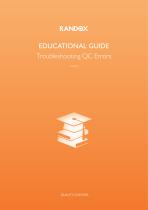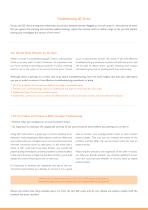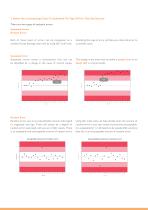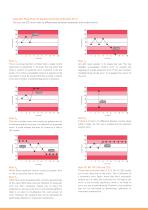 Website:
Randox Laboratories
Website:
Randox Laboratories
Group: Randox
Catalog excerpts

EDUCATIONAL GUIDE Troubleshooting QC Errors QUALITY CONTROL
Open the catalog to page 1
Troubleshooting QC Errors So you ran QC this morning and realised that one of your analytes has been flagged as “out-of-control”, what do you do next? Do you ignore the warning and continue patient testing, repeat the control until it’s within range or do you halt patient testing and investigate the source of the error? Your QC Has Failed, What Do You Do Next? When it comes to troubleshooting QC errors, unfortunately there is no easy path to take. However, it’s important that you have standard operating procedures in place, outlining what to do in the event of an out-of-control error....
Open the catalog to page 2
2. Review Your Levey-Jennings Charts To Understand The Type Of Error That Has Occurred There are two types of analytical errors: Systematic Errors Random Errors Both of these types of errors can be recognised on a standard Levey-Jennings chart and by using QC multi-rules. Identifying the type of error will help you relate the error to a possible cause. Systematic Error Systematic errors create a characteristic bias and can be identified by a change in the mean of control values. The change in the mean may be either a gradual trend or an abrupt shift in control results. Standard Deviation...
Open the catalog to page 3
Using QC Multi-Rules To Identify Systematic & Random Error You can use QC multi-rules to differentiate between systematic and random error. +3s Standard Deviation Standard Deviation This is a warning rule that is broken when a single control observation is outside the +/-2s limits. This rule warns that either a random or systematic error is present in the test system. If no other unacceptable results are apparent in the test system, it must be assumed that this is simply a random error and no further troubleshooting action is necessary. Any QC result outside +/-3s breaks this rule. This...
Open the catalog to page 4
3. Relate The Type Of Error To Possible Causes Ask yourself questions in order of likely relevance and review the most common solutions to the problem. Dependent on whether you have identified a systematic or random error in your system, this can help you determine the possible root cause of the error. See below for some common causes of systematic and random errors. Systematic Error: Shift 1. Change or failure in light source 2. Major instrument maintenance 3. Failure in sampling system 4. Change in temperature 5. Failure in reagent dispense system 6. Change in reagent formulation 7. New...
Open the catalog to page 5
ACUSERA True third party quality controls As a world leading manufacturer of multi-analyte true third party controls, thousands of laboratories rely on Randox to accurately assess test system performance and ultimately empower them with the confidence required to release patient test results. With more than 390 analytes available, the number of individual controls required to cover your test menu is significantly reduced while simultaneously reducing costs, time and storage space. A choice of formats is available, including liquid or lyophilised, which ensures flexibility and suitability...
Open the catalog to page 6
ACUSERA 24•7 Interlaboratory Data Management Designed for use with the Acusera range of third party controls, the Acusera 24•7 software helps laboratories monitor and interpret their QC data. Access to an impressive range of features, including interactive charts, the automatic calculation of Measurement Uncertainty & Sigma Metrics and live peer group data generated from our extensive database of laboratory participants, ensures Acusera 24•7 is the most comprehensive package available. • Advanced statistical analysis with automatic calculation of performance metrics including; Sigma, UM, TE...
Open the catalog to page 7
Copyright © 2019 Randox Laboratories Ltd. All rights Reserved. VAT number: GB 151682708. Product availability may vary from country to country. Some products may be for Research Use Only. For more information on product application and availability, please contact your local Randox Representative.
Open the catalog to page 8All Randox Laboratories catalogs and technical brochures
-
LT735 Vivalytic Overview
32 Pages
-
Acusera New Controls
8 Pages
-
Acusera 24.7
24 Pages
-
Acusera Third Party Controls
108 Pages
-
Acusera SMART Controls
12 Pages
-
Company Overview
40 Pages
-
Reagents Brochure
64 Pages
-
sdLDL-C
8 Pages
-
RX SERIES ANALYSER OVERVIEW
24 Pages
-
RX modena
20 Pages
-
RX misano
20 Pages
-
RX Daytona Plus
20 Pages
-
Rx Imola
20 Pages
-
RX Monaco
20 Pages
-
2024 Product List
64 Pages
-
LT107 Evidence Investigator
32 Pages
-
VeraSTAT-V
16 Pages
-
LT033 RIQAS Explained
64 Pages
-
VERASTAT
16 Pages
-
Endocrine Array
4 Pages
-
Cerebral Arrays
4 Pages
-
Thyroid Arrays
4 Pages
-
Respiratory Multiplex Array
8 Pages
-
LT253 Molecular Diagnostics
20 Pages
-
LT367 FH Array Brochure
4 Pages
-
The role of EQA in QC
8 Pages
-
Basic QC Stastics
8 Pages
-
Commutability Guide
4 Pages
-
How to measure uncertainty
8 Pages
-
ISO 15189 Educational Guide
8 Pages
-
Qnostics
52 Pages
-
Adiponectin LT519
28 Pages
-
Specific Proteins
40 Pages
-
Linearity sets
12 Pages
-
Antioxidants
16 Pages
-
Cardiology & Lipid Testing
28 Pages
-
Diabetes Portfolio
28 Pages
-
Total Bile Acids
4 Pages
-
VIVALYTIC
30 Pages
-
RANDOX DISCOVERY
36 Pages
-
HbA1c
2 Pages
-
Preparing QC
1 Pages
-
Point of Care Testing
12 Pages
-
LT394 Using QC Multirules
1 Pages
-
Guide to running QC
1 Pages
-
Tumour Marker Arrays
4 Pages
-
Which QC is the Right QC
8 Pages
-
How often is right for QC
6 Pages
-
Cardiac Risk Multiplex Array
4 Pages
-
LT241 Metabolic Array MAY15
8 Pages
-
KRAS / BRAF / PIK3CA Array*
4 Pages
-
Custom Arrays for Biochip
12 Pages
-
LT169 Cardiac Array
4 Pages
Archived catalogs
-
ACUSERA
108 Pages
-
Evidence Evolution
28 Pages
-
Evidence
16 Pages
-
Metabolic Syndrome Arrays
8 Pages
-
STI Multiplex Array
8 Pages
-
Molecular Testing
16 Pages
-
Evidence Investigator
20 Pages
-
Fertility Array
4 Pages
-
Rx Daytona
16 Pages
-
Evidence Investigator
16 Pages
-
Evidence
16 Pages





















































































